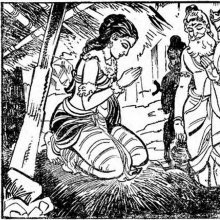Hermitage: 2 definitions
Introduction:
Hermitage means something in the history of ancient India. If you want to know the exact meaning, history, etymology or English translation of this term then check out the descriptions on this page. Add your comment or reference to a book if you want to contribute to this summary article.
Images (photo gallery)
India history and geography
Source: Suomen Antropologi: Sacred Trees among the Tamil people of South IndiaHermitage (in Sanskrit: āśrama) refers to a “place of refuge for spiritual seekers”.—The forest was the home of indigenous tribes with their strange and different life, very different to that experienced in controlled village existence. It was also the residence of hermits and sādhus (holy men) who were known and feared for their ascetic powers that could harm people if their anger were aroused. [...] he beauty of the forests was described by Vālmīki in several verses in the Āraṇyakas (Forest books) of the Rāmāyaṇa. In the epic, the forest is sanctified as a mystic place where spiritual seekers search refuge in āśrama (a place of refuge or hermitage) for the perfection and the state of mokṣa (spiritual liberation). The forests in which Rama the hero and Sita the heroine were dwelling also made those places sacred just through their bare presence.
Source: Singhi Jain Series: Ratnaprabha-suri’s Kuvalayamala-katha (history)Hermitages in ancient India were places where one can could Study (the tenets of religion and philosophy) and pursue the spiritual life, as vividly depicted in the Kathās (narrative poems) such as Uddyotanasūri in his 8th-century Kuvalayamālā (a Prakrit Campū, similar to Kāvya poetry).—The Kuvalayamala (779 A.D.) is full of cultural material which gains in value because of the firm date of its composition. [...] Page 87.20-28: Here is a vivid description of the intellectual and spiritual life in the Aśrama of a Jaina Muni, somewhat similar to that in the hermitage of Divākara Mitra described by Bāṇa in the Harṣacarita where scholars studied, devoted and held controversies, disputations and exchange of views on several points of religion and philosophy. A similar atmosphere is envisaged by Uddyotanasūri writing a century and a half after Bāṇa. He gives a list of twenty-one methods of study and discussions and approaches to the tenets of religion and philosophy, [...].

The history of India traces the identification of countries, villages, towns and other regions of India, as well as mythology, zoology, royal dynasties, rulers, tribes, local festivities and traditions and regional languages. Ancient India enjoyed religious freedom and encourages the path of Dharma, a concept common to Buddhism, Hinduism, and Jainism.
See also (Relevant definitions)
Full-text (+534): Ashrama, Badarikashrama, Siddhashrama, Aranyavasa, Parnotaja, Ashramavasin, Badarika, Munisthana, Pannasala, Ashramasthana, Ashramika, Ashramapada, Ashramamandala, Mahashrama, Bharatashrama, Assama, Arannavihara, Nirashramapada, Vidhvastanagarashrama, Arannakutika.
Relevant text
Search found 159 books and stories containing Hermitage; (plurals include: Hermitages). You can also click to the full overview containing English textual excerpts. Below are direct links for the most relevant articles:
Formal Education System in Ancient India (by Sushmita Nath)
Education in the Epic Period < [Chapter 1 - Introduction]
Tours or Travelling (as a method of teaching) < [Chapter 6 - Methods of Teaching and the Teacher–Student relationship]
The Gurukula centre of learning < [Chapter 3 - Centres of Learning in Vedic and Buddhist Period]
Ramayana of Valmiki (by Hari Prasad Shastri)
Chapter 116 - The holy men of Cittrakuta depart < [Book 2 - Ayodhya-kanda]
Chapter 51 - Gautama’s son Shatananda < [Book 1 - Bala-kanda]
Chapter 99 - The four brothers meet with tears of joy < [Book 2 - Ayodhya-kanda]
Harshacharita (socio-cultural Study) (by Mrs. Nandita Sarmah)
Part 4: Seats of Learning < [Chapter 3 - Education System]
2. Description of Hermitage Life < [Chapter 6 - Other Socio-Cultural Aspects]
Cultural Aspects (Introdcution) < [Chapter 6 - Other Socio-Cultural Aspects]
The Nilamata Purana (by Dr. Ved Kumari)
Trishashti Shalaka Purusha Caritra (by Helen M. Johnson)
Part 3: Mahāvīra’s stay at Morāka < [Chapter III - Mahāvīra’s first six years as an ascetic]
Part 5: Death of Rāma < [Chapter IV - Subhūmacakravartīcaritra]
Part 6: Mahāpadma’s adventures in voluntary exile < [Chapter VIII - Śrī Mahāpadmacakricaritra]
Puranic encyclopaedia (by Vettam Mani)
Related products


